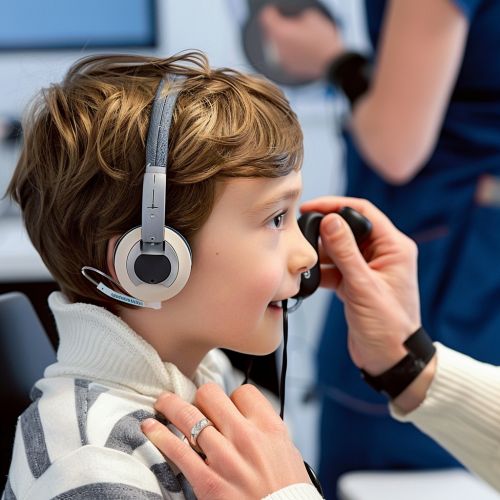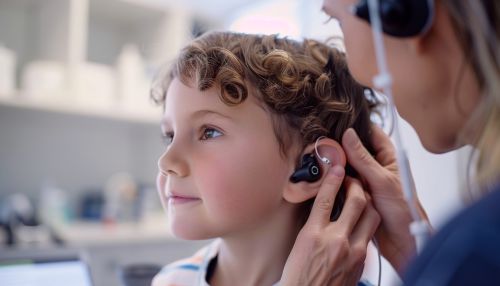Hearing loss in children
Introduction
Hearing loss in children is a significant health concern that can impact language development, communication skills, academic performance, and social interactions. This article provides a comprehensive overview of the causes, diagnosis, treatment, and management of hearing loss in pediatric populations.
Types of Hearing Loss
Hearing loss in children can be classified into three main types: conductive, sensorineural, and mixed hearing loss.
Conductive Hearing Loss
Conductive hearing loss occurs when there is a problem with the outer or middle ear that prevents sound from being conducted to the inner ear. Common causes include otitis media, earwax buildup, and congenital malformations of the ear canal or ossicles.
Sensorineural Hearing Loss
Sensorineural hearing loss results from damage to the inner ear (cochlea) or the auditory nerve. This type of hearing loss can be caused by genetic factors, prenatal infections such as cytomegalovirus, exposure to ototoxic medications, or complications during birth.
Mixed Hearing Loss
Mixed hearing loss is a combination of conductive and sensorineural hearing loss. It can result from conditions that affect both the outer/middle ear and the inner ear or auditory nerve.
Causes of Hearing Loss in Children
The causes of hearing loss in children can be broadly categorized into genetic, environmental, and idiopathic factors.
Genetic Factors
Genetic factors account for approximately 50% of cases of congenital hearing loss. Mutations in genes such as GJB2, which encodes the protein connexin 26, are common causes. Syndromic hearing loss, associated with conditions like Usher syndrome and Waardenburg syndrome, involves hearing loss along with other clinical features.
Environmental Factors
Environmental factors include prenatal infections (e.g., rubella, toxoplasmosis), perinatal complications (e.g., low birth weight, hypoxia), and postnatal infections (e.g., bacterial meningitis). Exposure to loud noises and ototoxic drugs (e.g., aminoglycosides) can also contribute to hearing loss.
Idiopathic Factors
In some cases, the cause of hearing loss remains unknown despite thorough investigation. These cases are classified as idiopathic.
Diagnosis
Early diagnosis of hearing loss in children is crucial for timely intervention and management. The diagnostic process involves several steps:
Newborn Hearing Screening
Universal newborn hearing screening (UNHS) programs aim to identify hearing loss at birth. Techniques such as otoacoustic emissions (OAE) and auditory brainstem response (ABR) testing are commonly used.
Audiological Evaluation
If a child fails the newborn hearing screening, a comprehensive audiological evaluation is conducted. This includes behavioral audiometry, tympanometry, and speech audiometry to assess the type and degree of hearing loss.
Medical and Genetic Evaluation
A thorough medical history and physical examination are essential to identify potential causes of hearing loss. Genetic testing may be recommended if a hereditary cause is suspected.
Treatment and Management
The management of hearing loss in children depends on the type, degree, and cause of the hearing loss. Interventions may include medical, surgical, and rehabilitative approaches.
Medical Management
Medical management may involve treating underlying conditions such as otitis media with antibiotics or anti-inflammatory medications. In cases of sensorineural hearing loss, corticosteroids may be used to reduce inflammation and improve hearing.
Surgical Management
Surgical interventions include procedures such as tympanostomy tube insertion for recurrent otitis media, ossiculoplasty for ossicular chain abnormalities, and cochlear implantation for severe to profound sensorineural hearing loss.
Rehabilitative Management
Rehabilitative management focuses on maximizing the child's hearing and communication abilities. This may involve the use of hearing aids, cochlear implants, and assistive listening devices. Speech and language therapy is also an integral part of the rehabilitation process.
Impact on Development
Hearing loss can significantly impact a child's language, cognitive, and social development. Early identification and intervention are critical to mitigating these effects.
Language Development
Children with hearing loss may experience delays in speech and language acquisition. Early intervention with hearing aids or cochlear implants, combined with speech therapy, can help improve language outcomes.
Cognitive Development
Hearing loss can affect cognitive development, including attention, memory, and executive function. Children with hearing loss may require additional support in educational settings to achieve their full potential.
Social Development
Hearing loss can impact social interactions and peer relationships. Children with hearing loss may experience social isolation and difficulties in communication. Social skills training and support groups can help address these challenges.
Prevention
Preventive measures can reduce the risk of hearing loss in children. These include:
Prenatal Care
Good prenatal care, including vaccination against rubella and avoiding ototoxic medications, can help prevent congenital hearing loss.
Early Detection and Treatment
Early detection and treatment of ear infections and other conditions that can cause hearing loss are essential. Regular hearing screenings and prompt medical attention for ear-related issues are recommended.
Noise Protection
Protecting children from exposure to loud noises can prevent noise-induced hearing loss. This includes using ear protection in noisy environments and limiting the use of personal audio devices at high volumes.
Research and Future Directions
Ongoing research aims to improve the understanding, diagnosis, and treatment of hearing loss in children. Advances in genetic testing, auditory prostheses, and regenerative medicine hold promise for the future.
Genetic Research
Genetic research is focused on identifying new genes associated with hearing loss and understanding the mechanisms by which genetic mutations cause hearing impairment. This knowledge can lead to targeted therapies and personalized medicine approaches.
Auditory Prostheses
Innovations in auditory prostheses, such as cochlear implants and bone-anchored hearing aids, are improving outcomes for children with hearing loss. Research is ongoing to enhance the performance and accessibility of these devices.
Regenerative Medicine
Regenerative medicine approaches, including gene therapy and stem cell therapy, are being explored as potential treatments for sensorineural hearing loss. These therapies aim to repair or replace damaged hair cells in the cochlea.
Conclusion
Hearing loss in children is a multifaceted condition with significant implications for development and quality of life. Early diagnosis, appropriate intervention, and ongoing support are essential to optimize outcomes for affected children. Continued research and advancements in medical technology hold promise for improving the lives of children with hearing loss.


See Also
- Otitis Media
- Cytomegalovirus
- Usher Syndrome
- Waardenburg Syndrome
- Rubella
- Toxoplasmosis
- Bacterial Meningitis
- Aminoglycosides
- Otoacoustic Emissions
- Auditory Brainstem Response
- Tympanometry
- Cochlear Implant
